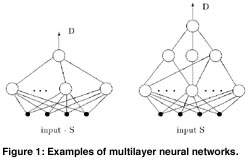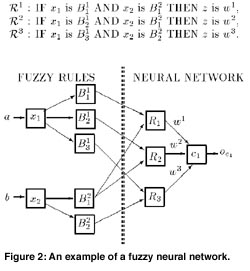

by Gabriela Andrejková, Henrich Tóth and Karel Kudela
Dynamical neural networks are used for geomagnetic storm predictions. A research team at J-P Safárik University in Kosice studies fuzzy neural network models which for such type of predictions look to be useful too.
Strong disturbances of the geomagnetic field, the geomagnetic storms initiated from the interplanetary space, along with the related enhanced energetic particle emissions have many consequences both on space and on the ground activities. Energetic particles are causing damage in space and the aircraft electronics leading to eventual failures of the systems; radiation hazard for the astronauts is increasing; the state of the ionosphere is changed and telecommunication systems are affected; geomagnetically induced currents can disturb the pipelines etc. Thus the prediction of the events, when suddenly (during few hours) the horizontal component of the geomagnetic field is depressed are of practical importance. Many schemes of the prediction are using ‘prehistory’, ie time series of interplanetary magnetic field and of solar wind plasma records monitored on the satellites outside the Earth magnetosphere.
Neural Networks are used for prediction of events (eg function fitting) and we could find many results about using multilayer feed-forward networks with error backpropagation learning strategy. The multilayer networks (see figure 1) belongs to the class of supervised networks, ie they learn from known answers.

From our point of view, ‘neuro-fuzzy’ means the employment of learning strategies derived from the domain of neural network theory to support the development of fuzzy systems. The learning capability of neural networks made them a prime target for combination with fuzzy systems in order to automate or support the process of developing a fuzzy system. Modern neuro-fuzzy systems (NFSs) are usually represented as multilayer feedforward systems, but it is possible to use the other network architecture, which means that the systems can have different properties:
The neuro-fuzzy classifier (NFC) is a modified neuro-fuzzy system that finds a solution of the classification problem. The main difference between the NFS and NFC is in the structure of IF – THEN rules.
Neuro-fuzzy Learning from the Data
The algorithm creates the rules for the training data and the structure of the fuzzy neural network. The algorithm can be used to initialize the network.
The main problem is to construct the knowledge base of fuzzy rules for the given data space. Figure 2 gives an example of a fuzzy neural network for the knowledge base.

The prediction of geomagnetic storms is made on the basis of parameters. To prepare the training and testing samples we used the data from years 1980-1984 and 1989-1998 available from the NASA (http://nssdc.gsfc.nasa.gov) because we had the continued values of parameters which are measured at each hour and relatively few measured values were missing. The data from the years 1980, 1981 and 1991 were used as the training samples, while the remaining examples were used for the testing.
Discussion and Conclusion
Several years of hourly records were examined. The years 1980, 1981 and 1991 with rather large number of geomagnetic storms were taken as training samples, while years 1982-1984, 1989-1990 and 1992-1998 as testing ones. FNN approach demonstrated to be useful in the schemes of preditions of geomagnetic storms.
The schemes developed will be used for systematical checking of relevance of other physical parameters (eg, cosmic ray time series measured by ground based global network of neutron monitors ) for the preditions of geomagnetic storms.
Please contact:
Gabriela Andrejková, Henrich Tóth - P.J. Safárik University, Kosice/SRCIM
Tel: +421 95 62 21 128
E-mail: andrejk@kosice.upjs.sk, toth@duro.upjs.sk
Karel Kudela - Institute of Experimental Physics, SAS, Kosice
Tel: +421 95 62 21 129
E-mail: kkudela@kosice.upjs.sk